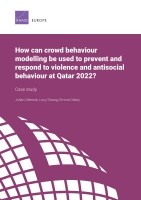| 来源类型 | Research Reports
|
| 规范类型 | 报告
|
| DOI | https://doi.org/10.7249/RR2736
|
| 来源ID | RR-2736-QAT
|
| How can crowd behaviour modelling be used to prevent and respond to violence and antisocial behaviour at Qatar 2022? |
| Julian Glenesk; Lucy Strang; Emma Disley
|
| 发表日期 | 2018
|
| 出版年 | 2018
|
| 页码 | 18
|
| 语种 | 英语
|
| 结论 |
- Crowd behaviour modelling (CBM) is the practice of simulating and predicting pedestrian movements within a space such as a stadium, using specialist modelling software.
- It informs the physical design of stadiums as well as the management of people and crowds within a space once stadiums are built and in use, to minimise the risk of and harm from any violent or antisocial behaviour.
- CBM can capture the complex cultural, individual and environmental differences in how people move in a space to predict how mixed crowds behave.
- CBM is most effective when it is collaborative and iterative between the experts carrying out the modelling, the client and relevant parties such as stadium security officers.
- CBM allows event planners to see how features of the environment, such as using wayfaring strategies or reducing queuing time for security, have an impact on crowd behaviour and safety.
|
| 摘要 |
- The World Cup brings together individuals from a range of national and cultural traditions, with different norms about behaviours and movement in a crowd, which means that crowd behaviour might change depending on the makeup of the crowd at a given match. CBM can be used to help plan bespoke crowd management approaches for Qatar 2022.
- In addition to using CBM within the stadiums, Qatar 2022 planners could use the method to undertake modelling in other areas where it is expected fans will congregate, such as fan zones and public transport stations
- The development of models should be undertaken with close collaboration between contractors undertaking the modelling and the individuals who are responsible for the day-to-day operational management of the modelled space.
- CBM adds most value when it takes place early enough for the layout of key outdoor spaces and stadiums to be changed according to the results of the modelling.
- CBM is most effective when is highly tailored to the specific details of the space and the make-up of the crowd.
- CBM should be undertaken in parallel with operational planning such as the training given to all those involved in managing the space (police, volunteers, security personnel, etc.).
- Stadiums in similar environments should be examined for guidance and lessons learned.
|
| 主题 | Crime and Violence Prevention
; Law Enforcement
; Modeling and Simulation
; Qatar
; Urban Planning
; Violence
|
| URL | https://www.rand.org/pubs/research_reports/RR2736.html
|
| 来源智库 | RAND Corporation (United States)
|
| 引用统计 |
|
| 资源类型 | 智库出版物
|
| 条目标识符 | http://119.78.100.153/handle/2XGU8XDN/108929
|
推荐引用方式
GB/T 7714 |
Julian Glenesk,Lucy Strang,Emma Disley. How can crowd behaviour modelling be used to prevent and respond to violence and antisocial behaviour at Qatar 2022?. 2018.
|
|
文件名:
|
x1544546014615.jpg
|
|
格式:
|
JPEG
|

|
文件名:
|
RAND_RR2736.pdf
|
|
格式:
|
Adobe PDF
|
除非特别说明,本系统中所有内容都受版权保护,并保留所有权利。